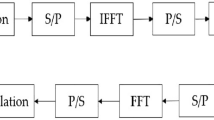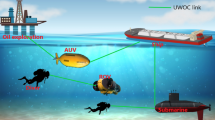Abstract
An ultra wideband (UWB) communications system that applies time reversal to transmit the desired signal is investigated. Exact expressions for the first- and second-order moments, cross-correlation, intersymbol interference metric, and correlation coefficient of time reversal (TR) UWB equivalent channel are derived in terms of the physical channel parameters such as delay spread and mean excess delay. These expressions are verified by simulated and experimental results. It is shown that TR-UWB excess delay is very smaller than UWB and its delay spread decreases as signaling bandwidth increases. Semi-analytical results show that the time reversal UWB delay spread is approximately the same as UWB. Furthermore, an ISI metric is derived for TR-UWB channel based on transmitted signal and UWB channel parameters. Moreover, correlation coefficient of two TR-UWB received signals with different power delay profile is computed analytically. Simulation and analytical results show that for τ > 0.3T w correlation coefficient is below 0.25 and for τ > T w correlation coefficient is zero, where T w is the transmitted pulse width. Finally, theoretical performance of a receiver with one tap matched filter is computed and compared with measured and simulated result.













Similar content being viewed by others
Notes
This notation is the same as I A (t) in [3]. Because channel impulse response is denoted with h(t), we exchange g(t) and h(t) in this paper.
Due to this assumption and some approximations which are used in this paper, we anticipate some inaccuracy.
References
Kyritsi P and Papanicolaou G (2007) Time-reversal: spatio-temporal focusing and its dependence on channel correlation. International Conference on Signal Processing and Communication Systems ICSPCS 2007, Gold Coast, Australian, 17–19
Foerster J and Qinghua Li (2002) UWB Channel Modeling Contribution from Intel. IEEE P802.15 Wireless Personal Area Network
Witrisal K, Pausini M (2008) Statistical analysis of UWB channel correlation functions. IEEE Trans Veh Technol 57(3):1359–1373
Molisch AF (2005) Ultrawideband propagation channels—theory, measurement, and modeling. IEEE Trans Veh Technol 54(5):1525–1545
Khaleghi A (2009) Measurement and analysis of ultra-wideband time reversal for indoor propagation channels. Wireless Pers Comm 54:307–320. doi:10.1007/s11277-009-9727-y
Chen Y, Beaulieu NC (2007) Moment based interference analysis of CM1, CM2, CM3 and CM4 UWB Systems. IEEE GLOBECOM 2007 proceedings, 26–30, Washington
Qiu RC, Zhou CJ, Guo N, Zhang JQ (2006) Time reversal with MISO for ultrawideband communications: experimental results. IEEE Antennas Wireless Prop Lett 5:269–273
Zhang W, Abhayapala TD (2005) UWB Spatial-Frequency Channel Characterization. 63th IEEE Vehicular Conference (VTC) Melbourne
Win MZ, Scholtz RA (1998) On the energy capture of ultrawide bandwidth signals in dense multipath environments. IEEE Commun Lett 2(9):245–247
Rappaport T (2002) Wireless communications: principles and practice, 2nd edn. Pearson, New York
Pajusco P, Pagani P (2009) On the use of uniform circular arrays for characterizing UWB time reversal. IEEE Trans Antennas Propag 57(1):102–109
Malik WQ, Edwards DJ, Stevens CJ (2007) Frequency dependence of fading statistics for ultrawideband systems. IEEE Trans Wireless Commun 6(3):800–804
Cassioli D, Win MZ, Molisch AR (2001) “A Statistical Model for the UWB Indoor Channel”. IEEE VTC Spring 53 rd 2:1159–1163
Witrisal K (2008) Statistical analysis of the IEEE 802.15.4a UWB PHY over Multipath Channels. Wireless Communications and Networking Conference. WCNC2008. IEEE March 31–April 3 2008
Abbasi-moghadam D, Tabataba Vakili V (2010) Characterization of Indoor Time Reversal UWB Communication Systems: Spatial, Temporal and Frequency Properties, Wiley International Journal of Communication Systems. doi:10.1002/dac.1140, published online 28 April 2010
Acknowledgements
The authors would like to thank ITRC (Iran telecommunication Research Center) for their invaluable assistance and funding for this research.
Author information
Authors and Affiliations
Corresponding author
Appendices
Appendix 1—autocorrelation
Aim of this appendix is the derivation of the autocorrelation of the received pulse in TR-UWB defined as: \( R\left( {{t_1},{t_2}} \right) = E\left( {{h_{\rm{eq}}}({t_1})h_{\rm{eq}}^{*}({t_2})} \right) \). Since E{α i α j } = 0, and \( E\left\{ {\alpha_i^3{\alpha_j}} \right\} = 0 \), \( E\left\{ {\alpha_i^2\alpha_j^2} \right\} = E\left\{ {\alpha_i^2} \right\}E\left\{ {\alpha_j^2} \right\} \) for i ≠ j, similar to [3], autocorrelation is
Using uncorrelated scattering properties
We study the three terms in the above equation, and we denote each one with the corresponding roman number.
The first term can be rewritten as follows
where \( {\varphi_w}(t) = \int\limits_A {w(\tau } )w(t + \tau )d\tau \, \).
Expectation and variance of \( \sum {\alpha_i^2} \) is [3]
Using (57), E {Σ α i }2 is [3]
Using (58), (56) can be written as
The second term in (55) is
As it is known
By supposing \( \mu = t + \xi \), it is shown that \( E\left\{ {(g(t)g(t + \xi } \right\} = {p_g}(t){\phi_w}(\xi ) \), so
where \( A\prime = \left[ {a - t,a - t + {\tau_I}} \right]\, \).
The third term, the following expression is
And obtain (13) from (59), (63), and (65).
Appendix 2—means excess delay and delay spread
Aim of this appendix is the derivation of the mean excess delay in TR-UWB systems based on UWB mean excess delay and UWB PDP. In observation interval of A = [0,∞], by substituting (27) in (26) mean excess delay is
Supposing that \( t + \tau = \beta \) and substituting (28) in (67)
By supposing \( {c_1}{\bar{\tau }_{\phi_{_w}^2}} = \int\limits_{ - \infty }^\infty \tau \phi_w^2(\tau )d\tau \)
In observation interval of A = [0,∞]
And the TR-UWB PDP is
Therefore,
It is obvious that \( \frac{{{c_1} + {c_2}}}{T}{T_w} < < \frac{{{c_1}}}{2}{e^{ - \frac{{{T_w}}}{T}}} \), so
As it is seen from (73), \( {\bar{\tau }_{\rm{TR}}} \)is mostly near zero. Because of symmetric property of equivalent channel impulse response of TR-UWB in observation interval of \( A = [ - \infty \,,\,\infty ] \), its mean excess delay is zero.
TR-UWB delay spread (RMS delay) in observation interval of \( A = [ - \infty \,,\,\infty ] \) is
Using \( \frac{{{c_1} + {c_2}}}{T}{T_w} < < \frac{{{c_1}{e^{ - \frac{{{T_w}}}{T}}}}}{2} \) and
Replacing (76) in (75), TR-UWB delay spread is
Rights and permissions
About this article
Cite this article
Abbasi-Moghadam, D., Tabataba Vakili, V. Channel characterization of time reversal UWB communication systems. Ann. Telecommun. 65, 601–614 (2010). https://doi.org/10.1007/s12243-010-0189-8
Received:
Accepted:
Published:
Issue Date:
DOI: https://doi.org/10.1007/s12243-010-0189-8




